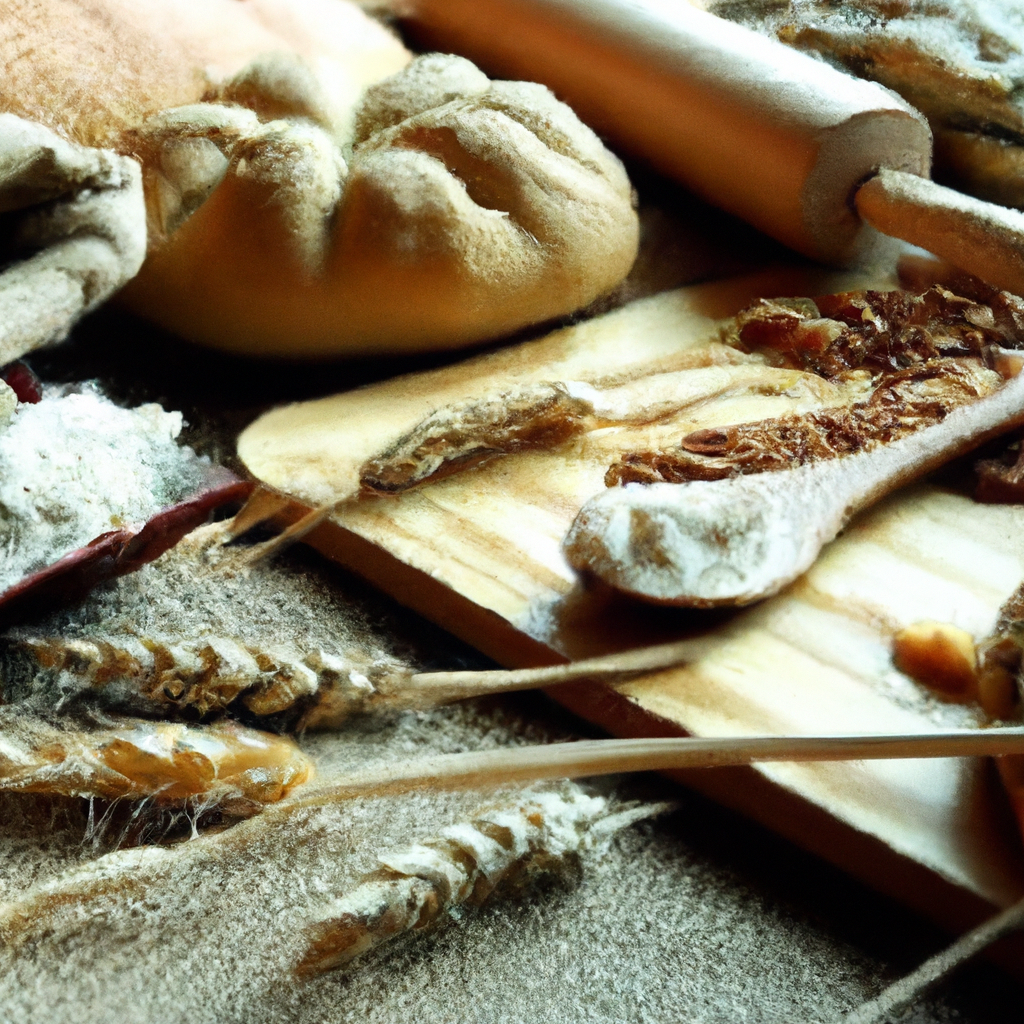The Complete Guide To Thriving On A Gluten-Free Diet
Are you ready to embark on a gluten-free journey that will leave you feeling energized, healthy, and satisfied? Look no further than “The Complete Guide to Thriving on a gluten-free diet.” Packed with practical tips, delicious recipes, and expert advice, this comprehensive guide will empower you to navigate the challenges and embrace the abundance of a gluten-free lifestyle. Whether you’re a well-seasoned gluten-free veteran or just starting out, this article is your compass to a vibrant and fulfilling life without gluten. Say goodbye to gluten and hello to a world of taste and well-being!

Understanding Gluten and the Gluten-Free Diet
What is gluten?
Gluten is a protein found in certain grains, including wheat, barley, and rye. This protein gives dough its elasticity and helps it hold its shape. It is commonly found in foods such as bread, pasta, and baked goods.
How does gluten affect the body?
For individuals with celiac disease, consuming gluten triggers an immune response that damages the lining of the small intestine. This can lead to a variety of symptoms, including abdominal pain, bloating, diarrhea, and nutrient deficiencies. Gluten sensitivity, on the other hand, may cause similar symptoms but does not involve an immune response or damage to the small intestine.
What is a gluten-free diet?
A gluten-free diet involves avoiding foods that contain gluten. This includes eliminating obvious sources of gluten, such as bread and pasta, but also being mindful of hidden sources of gluten in processed foods, sauces, and condiments. It is important to carefully read food labels and choose products that are labeled gluten-free or certified gluten-free.
Who should follow a gluten-free diet?
A gluten-free diet is essential for individuals with celiac disease, as consuming gluten can lead to serious health complications. Additionally, individuals with gluten sensitivity or wheat allergies may also benefit from avoiding gluten. However, it is best to consult with a healthcare provider or registered dietitian before making any drastic dietary changes.
Transitioning to a Gluten-Free Lifestyle
Educate yourself about gluten-free foods
When transitioning to a gluten-free lifestyle, it is crucial to educate yourself about gluten-free foods. Take the time to learn about alternative grains and ingredients that can be used in place of gluten-containing ones. This will help you make informed choices when grocery shopping and preparing meals.
Read food labels carefully
Reading food labels is essential in identifying gluten-containing ingredients. Look for products that are specifically labeled as gluten-free or certified gluten-free. It is also important to be aware of ingredients that may indicate the presence of gluten, such as wheat, barley, and rye. Familiarizing yourself with common sources of gluten will make it easier to avoid them.
Find gluten-free substitutes
Fortunately, there are many gluten-free substitutes available for traditional gluten-containing foods. From gluten-free bread and pasta to baking flour alternatives, there are options for almost every craving. Experiment with different brands and find the substitutes that best match your taste preferences. It may take some trial and error, but there are numerous delicious gluten-free options to explore.
Consult with a nutritionist or healthcare provider
If you are unsure about how to properly transition to a gluten-free lifestyle, it is beneficial to consult with a nutritionist or healthcare provider. They can guide you through the process and provide personalized recommendations based on your specific needs and dietary requirements. They can also help you address any potential nutrient deficiencies that may arise from eliminating gluten from your diet.
Creating a Gluten-Free Meal Plan
Identify gluten-free grains and foods
When creating a gluten-free meal plan, it is important to identify grains and foods that are naturally gluten-free. Examples of gluten-free grains include rice, quinoa, corn, and oats (as long as they are labeled gluten-free). Build your meals around these grains and incorporate a variety of gluten-free proteins, fruits, and vegetables.
Plan balanced meals
A balanced meal should contain a combination of protein, carbohydrates, and healthy fats. Aim to include a serving of lean protein, such as chicken, fish, or tofu, along with a gluten-free grain and a generous portion of vegetables. Adding a source of healthy fat, such as avocado or olive oil, can help increase satiety and provide important nutrients.
Incorporate a variety of fruits and vegetables
Fruits and vegetables are naturally gluten-free and offer a wide range of vitamins, minerals, and fiber. Aim to incorporate a variety of colors in your meals to ensure you are getting a diverse array of nutrients. Experiment with different cooking methods, such as roasting, steaming, or grilling, to enhance the flavors and textures of your produce.
Prepare gluten-free snacks and desserts
Snacking and enjoying desserts can still be part of a gluten-free lifestyle. Stock your pantry with gluten-free snack options, such as nuts, seeds, rice cakes, or gluten-free granola bars. For desserts, explore gluten-free baking recipes that use alternative flours, such as almond flour or coconut flour. There are also many gluten-free dessert options available in stores, ranging from cookies to ice cream.

Navigating the Grocery Store
Familiarize yourself with gluten-free product labels
Navigating the grocery store can be overwhelming when following a gluten-free diet. Take the time to familiarize yourself with gluten-free product labels, as they will guide you in making safe choices. Look for labels that clearly state “gluten-free” or “certified gluten-free.” This ensures that the product has met the necessary standards to be considered safe for those following a gluten-free diet.
Shop in the produce section
The produce section of the grocery store is a gluten-free haven. Fruits and vegetables are naturally gluten-free, so you can fill your cart with a variety of fresh produce. Experiment with different flavors and textures, and try to incorporate seasonal produce into your meals. This will not only add nutritional value to your diet but also keep your meals interesting and flavorful.
Explore the gluten-free aisle
Most grocery stores have a dedicated gluten-free aisle or section that offers a wide range of gluten-free products. This is a great place to find gluten-free versions of your favorite snacks, bread, pasta, and baking ingredients. Take your time to explore the options and find brands that align with your taste preferences. Don’t be afraid to try new products and experiment with different flavors.
Avoid cross-contamination
Cross-contamination can occur when gluten-free items come into contact with gluten-containing products or surfaces. To avoid this, it is important to be mindful of how you handle and store your gluten-free groceries. Keep gluten-free items separate from gluten-containing ones in your pantry, fridge, and freezer. Use separate utensils and cookware when preparing meals to prevent cross-contamination during cooking.
Eating Out Gluten-Free
Research gluten-free-friendly restaurants
When dining out, it can be helpful to research and identify gluten-free-friendly restaurants in your area. Look for establishments that have been certified as gluten-free or have a dedicated gluten-free menu. Check online reviews or reach out to the restaurant directly to ensure they can accommodate your dietary needs. Planning ahead will make the dining experience more enjoyable and stress-free.
Ask questions and communicate your needs
When dining out, don’t hesitate to ask questions and communicate your gluten-free needs to the staff. It is important to clearly explain your dietary restrictions and ask about gluten-free options or modifications to menu items. Additionally, be vigilant about potential cross-contamination risks and ask about the restaurant’s practices to ensure your meal is prepared safely.
Be cautious of hidden sources of gluten
Hidden sources of gluten can be lurking in unexpected places, such as sauces, dressings, and condiments. When dining out, be cautious of these hidden sources and ask for gluten-free alternatives or for these items to be served on the side. It is better to double-check and be safe rather than assuming something is gluten-free and risking exposure to gluten.
Consider ordering naturally gluten-free foods
Many cuisines offer naturally gluten-free options that can make dining out easier. Options such as grilled fish, salads, vegetable-based dishes, and grilled meats are often naturally gluten-free. Familiarize yourself with these options in different cuisines so that you can confidently order gluten-free meals when dining out.
Maintaining a Nutrient-Rich Gluten-Free Diet
Focus on whole, unprocessed foods
To maintain a nutrient-rich gluten-free diet, focus on incorporating whole, unprocessed foods into your meals. These include fruits, vegetables, lean proteins, nuts, seeds, and gluten-free grains. These foods are naturally rich in essential nutrients, such as vitamins, minerals, and fiber, and can provide a solid foundation for a healthy diet.
Include sources of protein and healthy fats
Protein and healthy fats play crucial roles in a balanced diet. Incorporate sources of protein, such as poultry, fish, tofu, legumes, and eggs, into your meals. Healthy fats can be found in foods like avocados, nuts, seeds, and olive oil. Including these nutrients in your diet will help promote satiety, support muscle growth and repair, and provide essential fatty acids.
Choose nutrient-dense gluten-free grains
While eliminating gluten-containing grains, it is important to choose gluten-free grains that are nutrient-dense. Opt for grains such as quinoa, brown rice, millet, and buckwheat, as they offer a range of vitamins, minerals, and fiber. Experiment with different grains to add variety and make your meals more exciting and nutritious.
Supplement when necessary
Following a gluten-free diet may increase the risk of certain nutrient deficiencies, such as iron, calcium, and B vitamins. If you are concerned about meeting your nutrient needs, consider working with a healthcare provider or registered dietitian to determine if any supplements are necessary. They can assess your individual needs and provide guidance on appropriate supplementation.
Dealing with Social Situations and Travel
Communicate your dietary restrictions with others
When attending social events or gatherings, it is crucial to communicate your dietary restrictions with others. Let your friends, family, and colleagues know about your gluten-free lifestyle, so they can accommodate your needs. This will help reduce any confusion or awkwardness when it comes to food and ensure that suitable options are available for you.
Plan ahead for social events and gatherings
To ensure you have gluten-free options available at social events and gatherings, it is helpful to plan ahead. Offer to bring a gluten-free dish that you can enjoy and share with others. If dining out, research the restaurant in advance or contact the host to discuss gluten-free options. By planning ahead, you can confidently enjoy social occasions while sticking to your gluten-free diet.
Pack gluten-free snacks while traveling
Traveling can pose a challenge for individuals following a gluten-free diet. To stay prepared, pack a variety of gluten-free snacks that will keep you satisfied while on the go. Nuts, seeds, dried fruit, gluten-free granola bars, and rice cakes are portable options that can help curb hunger and prevent you from relying on potentially gluten-containing options.
Research gluten-free options at your destination
Before traveling to a new destination, take the time to research gluten-free options in the area. Look for restaurants, markets, or specialty stores that cater to gluten-free diets. This will give you peace of mind knowing that you can find suitable options when eating away from home. Additionally, consider packing gluten-free essentials, such as bread or pasta, in case access to gluten-free options is limited.
Managing Cross-Contamination Risks
Keep your kitchen clean and organized
Maintaining a clean and organized kitchen is essential for managing cross-contamination risks. Clean countertops, cutting boards, and utensils thoroughly before and after preparing gluten-free meals. Keep gluten-free items separate from gluten-containing ones in your pantry, fridge, and freezer to prevent accidental contact.
Use separate utensils and cookware
Using separate utensils and cookware is another important step in avoiding cross-contamination in the kitchen. Invest in dedicated gluten-free kitchen tools to ensure that gluten-containing ones do not come into contact with your gluten-free meals. This includes separate cutting boards, toasters, and colanders.
Avoid shared appliances and surfaces
Shared appliances and surfaces, such as toasters, air fryers, and grills, can be a source of cross-contamination. If possible, designate separate appliances for gluten-free use or thoroughly clean them before preparing gluten-free meals. Use separate oven mitts or gloves when handling gluten-free and gluten-containing foods to minimize the risk of cross-contamination.
Educate family members and roommates
If you share a kitchen with family members or roommates, it is important to educate them about cross-contamination risks and your gluten-free needs. Clearly communicate the importance of keeping gluten-free items separate and avoiding cross-contamination. Encourage open communication and collaboration to ensure a supportive and safe kitchen environment.
Overcoming Challenges and Common Pitfalls
Recognize hidden sources of gluten
Hidden sources of gluten can often catch individuals off guard. Be aware of ingredients such as soy sauce, certain condiments, processed meats, and even medications, as they may contain gluten. Learning to read ingredient labels thoroughly and researching gluten-free alternatives can help you navigate through hidden sources and avoid accidental gluten exposure.
Address emotional challenges
Adapting to a gluten-free lifestyle can sometimes be emotionally challenging. It may require making significant changes to your favorite foods and adjusting to new flavors and textures. Additionally, social situations and dining out can be daunting. It is important to acknowledge these emotional challenges and seek support from family, friends, or online communities to help navigate through them.
Handle cravings and temptations
Cravings for gluten-containing foods can be difficult to manage when transitioning to a gluten-free lifestyle. Find gluten-free alternatives or recreate your favorite gluten-containing dishes using gluten-free ingredients. Experiment with different spices and seasonings to add flavor and make your meals more enjoyable. Over time, cravings for gluten may diminish as your taste buds adjust to the new flavors.
Seek support from gluten-free communities
Connecting with others who follow a gluten-free lifestyle can provide support, advice, and encouragement. Joining online gluten-free communities, attending local support groups, or participating in educational events can help you feel connected and gain valuable insights from others who have walked a similar path. Remember, you are not alone in your gluten-free journey.
Benefits and Potential Drawbacks of a Gluten-Free Diet
Improved digestion and nutrient absorption
For individuals with celiac disease or gluten sensitivity, following a gluten-free diet can lead to improved digestion and nutrient absorption. By eliminating gluten, the intestinal lining can heal, allowing proper absorption of nutrients from food. This can help alleviate symptoms such as bloating, diarrhea, and nutrient deficiencies.
Reduced inflammation and improved autoimmune conditions
Gluten has been associated with increased inflammation in the body, particularly in individuals with celiac disease or gluten sensitivity. Following a gluten-free diet can help reduce inflammation and potentially improve autoimmune conditions. However, it is important to note that not all autoimmune conditions are directly influenced by gluten, and individual responses may vary.
Weight management and increased energy levels
Some individuals may experience weight management benefits when following a gluten-free diet, particularly if they previously consumed a diet high in processed gluten-containing foods. Additionally, eliminating gluten-triggered inflammation may lead to increased energy levels and overall well-being.
Potential nutrient deficiencies and restricted food choices
One potential drawback of a gluten-free diet is the risk of nutrient deficiencies. Gluten-free products are not always fortified with the same nutrients found in their gluten-containing counterparts. Thus, individuals following a gluten-free diet should be mindful of obtaining adequate amounts of certain vitamins and minerals, such as iron, calcium, and B vitamins. Additionally, the necessity to eliminate gluten may lead to restricted food choices, making it important to plan and diversify meals carefully.
In conclusion, understanding gluten and the gluten-free diet is crucial for individuals with celiac disease, gluten sensitivity, or wheat allergies. Transitioning to a gluten-free lifestyle requires educating oneself about gluten-free foods, reading food labels, finding substitutes, and seeking guidance from healthcare providers. Creating a gluten-free meal plan involves identifying gluten-free grains and foods, planning balanced meals, incorporating fruits and vegetables, and preparing gluten-free snacks and desserts. Navigating the grocery store requires familiarizing oneself with gluten-free product labels, selecting produce, exploring the gluten-free aisle, and avoiding cross-contamination. Eating out gluten-free involves researching gluten-free-friendly restaurants, communicating dietary needs, being cautious of hidden gluten sources, and opting for naturally gluten-free foods. Maintaining a nutrient-rich gluten-free diet involves focusing on whole foods, including Protein and healthy fats, choosing nutrient-dense gluten-free grains, and potentially supplementing when necessary. Dealing with social situations and travel necessitates communicating dietary restrictions, planning ahead, packing gluten-free snacks, and researching gluten-free options. Managing cross-contamination risks involves keeping the kitchen clean and organized, using separate utensils and cookware, avoiding shared appliances and surfaces, and educating family members and roommates. Overcoming challenges and common pitfalls involves recognizing hidden gluten sources, addressing emotional challenges, handling cravings and temptations, and seeking support from gluten-free communities. Lastly, understanding the benefits and potential drawbacks of a gluten-free diet highlights improved digestion and nutrient absorption, reduced inflammation and improved autoimmune conditions, weight management and increased energy levels, and potential nutrient deficiencies and restricted food choices. With knowledge and careful planning, individuals can embrace a thriving gluten-free lifestyle.


Pingback: Achieving Healthy Weight: Converting 180 Pounds To Kilograms And Beyond
Pingback: Tasty Gluten-Free Snacks You'll Love